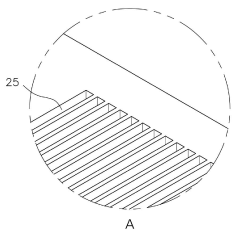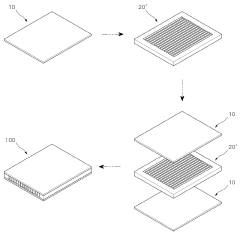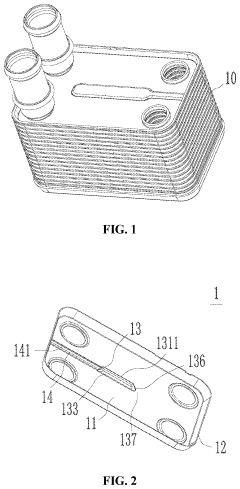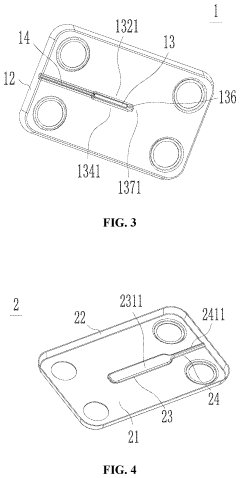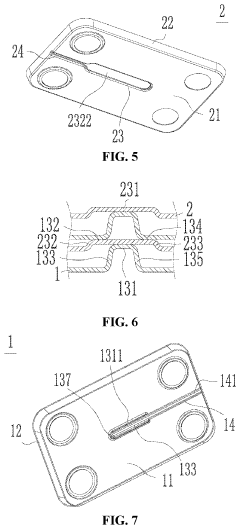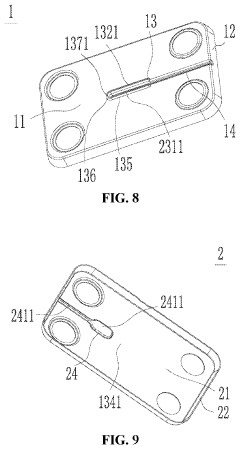Plate Heat Exchanger in High-Temperature Industrial Processes
JUL 15, 20259 MIN READ
Generate Your Research Report Instantly with AI Agent
Patsnap Eureka helps you evaluate technical feasibility & market potential.
PHE Technology Evolution
Plate heat exchangers (PHEs) have undergone significant technological evolution since their inception in the 1920s. Initially designed for low-temperature applications in the dairy industry, PHEs have progressively adapted to meet the demands of high-temperature industrial processes. This evolution has been driven by advancements in materials science, manufacturing techniques, and design optimization.
In the early stages, PHEs were limited to applications below 150°C due to the use of gaskets made from natural rubber compounds. The 1960s saw the introduction of synthetic elastomers, which expanded the temperature range to around 180°C. This breakthrough allowed PHEs to enter new industrial sectors, including chemical processing and petrochemicals.
The 1970s and 1980s marked a significant leap in PHE technology with the development of semi-welded and fully welded designs. These innovations eliminated the need for gaskets in high-temperature zones, enabling PHEs to operate at temperatures exceeding 200°C. Concurrently, improvements in plate corrugation patterns enhanced heat transfer efficiency and reduced fouling, addressing key challenges in high-temperature applications.
The 1990s witnessed the integration of computer-aided design (CAD) and computational fluid dynamics (CFD) in PHE development. These tools allowed engineers to optimize plate geometries and flow distributions, resulting in PHEs capable of handling temperatures up to 350°C while maintaining high thermal efficiency.
In the 2000s, the focus shifted towards materials innovation. The introduction of high-performance alloys, such as titanium and nickel-based superalloys, further expanded the temperature range of PHEs. These materials offered superior corrosion resistance and mechanical strength at elevated temperatures, enabling PHEs to operate in environments approaching 400°C.
Recent advancements in the 2010s and beyond have centered on enhancing the overall system performance of PHEs in high-temperature applications. This includes the development of advanced sealing technologies, such as graphite-based gaskets and metal-to-metal seals, which have pushed the temperature limits even higher. Additionally, the integration of smart sensors and real-time monitoring systems has improved the reliability and efficiency of PHEs in extreme conditions.
The latest frontier in PHE technology for high-temperature processes involves the exploration of novel manufacturing techniques, such as 3D printing and advanced welding methods. These innovations promise to revolutionize PHE design, allowing for more complex geometries and customized solutions that can withstand even more extreme temperature and pressure conditions.
Throughout this evolution, the core advantages of PHEs – compact size, high heat transfer efficiency, and flexibility – have been preserved and enhanced, making them increasingly attractive for a wide range of high-temperature industrial applications. The ongoing research and development in this field continue to push the boundaries of what is possible with plate heat exchanger technology in demanding thermal environments.
In the early stages, PHEs were limited to applications below 150°C due to the use of gaskets made from natural rubber compounds. The 1960s saw the introduction of synthetic elastomers, which expanded the temperature range to around 180°C. This breakthrough allowed PHEs to enter new industrial sectors, including chemical processing and petrochemicals.
The 1970s and 1980s marked a significant leap in PHE technology with the development of semi-welded and fully welded designs. These innovations eliminated the need for gaskets in high-temperature zones, enabling PHEs to operate at temperatures exceeding 200°C. Concurrently, improvements in plate corrugation patterns enhanced heat transfer efficiency and reduced fouling, addressing key challenges in high-temperature applications.
The 1990s witnessed the integration of computer-aided design (CAD) and computational fluid dynamics (CFD) in PHE development. These tools allowed engineers to optimize plate geometries and flow distributions, resulting in PHEs capable of handling temperatures up to 350°C while maintaining high thermal efficiency.
In the 2000s, the focus shifted towards materials innovation. The introduction of high-performance alloys, such as titanium and nickel-based superalloys, further expanded the temperature range of PHEs. These materials offered superior corrosion resistance and mechanical strength at elevated temperatures, enabling PHEs to operate in environments approaching 400°C.
Recent advancements in the 2010s and beyond have centered on enhancing the overall system performance of PHEs in high-temperature applications. This includes the development of advanced sealing technologies, such as graphite-based gaskets and metal-to-metal seals, which have pushed the temperature limits even higher. Additionally, the integration of smart sensors and real-time monitoring systems has improved the reliability and efficiency of PHEs in extreme conditions.
The latest frontier in PHE technology for high-temperature processes involves the exploration of novel manufacturing techniques, such as 3D printing and advanced welding methods. These innovations promise to revolutionize PHE design, allowing for more complex geometries and customized solutions that can withstand even more extreme temperature and pressure conditions.
Throughout this evolution, the core advantages of PHEs – compact size, high heat transfer efficiency, and flexibility – have been preserved and enhanced, making them increasingly attractive for a wide range of high-temperature industrial applications. The ongoing research and development in this field continue to push the boundaries of what is possible with plate heat exchanger technology in demanding thermal environments.
High-Temp Process Demands
High-temperature industrial processes are increasingly demanding more efficient and robust heat exchange solutions. These processes, often found in sectors such as petrochemicals, power generation, and metallurgy, operate at temperatures exceeding 400°C and require specialized equipment to manage heat transfer effectively. The market for high-temperature plate heat exchangers is driven by the need for improved energy efficiency, reduced operational costs, and enhanced process control in these demanding environments.
Industries such as oil refining and chemical manufacturing rely heavily on high-temperature processes, where efficient heat recovery and transfer are crucial for maintaining productivity and reducing energy consumption. The global push towards sustainability and energy conservation has further intensified the demand for advanced heat exchange technologies capable of withstanding extreme temperatures while maximizing thermal efficiency.
In power generation, particularly in concentrated solar power plants and advanced nuclear reactors, there is a growing need for heat exchangers that can operate reliably at elevated temperatures. These applications require materials and designs that can maintain structural integrity and performance under prolonged exposure to high-temperature fluids and thermal cycling.
The metallurgical industry, including steel and aluminum production, presents another significant market for high-temperature plate heat exchangers. These processes involve molten metals and aggressive environments, necessitating heat exchange solutions that can withstand corrosion, erosion, and thermal shock while ensuring consistent heat transfer rates.
Emerging technologies in hydrogen production and carbon capture also contribute to the demand for high-temperature heat exchangers. As these industries scale up, they require specialized heat transfer equipment capable of handling the extreme conditions associated with high-temperature electrolysis and thermochemical processes.
The market demand is not only focused on temperature resistance but also on compact designs that can reduce footprint in industrial settings. Plate heat exchangers, known for their high efficiency and small form factor, are increasingly being adapted for high-temperature applications to meet this need.
Furthermore, there is a growing emphasis on modular and flexible heat exchange systems that can be easily integrated into existing processes or scaled for new installations. This trend is driven by the need for rapid deployment and the ability to adapt to changing process requirements in dynamic industrial environments.
Industries such as oil refining and chemical manufacturing rely heavily on high-temperature processes, where efficient heat recovery and transfer are crucial for maintaining productivity and reducing energy consumption. The global push towards sustainability and energy conservation has further intensified the demand for advanced heat exchange technologies capable of withstanding extreme temperatures while maximizing thermal efficiency.
In power generation, particularly in concentrated solar power plants and advanced nuclear reactors, there is a growing need for heat exchangers that can operate reliably at elevated temperatures. These applications require materials and designs that can maintain structural integrity and performance under prolonged exposure to high-temperature fluids and thermal cycling.
The metallurgical industry, including steel and aluminum production, presents another significant market for high-temperature plate heat exchangers. These processes involve molten metals and aggressive environments, necessitating heat exchange solutions that can withstand corrosion, erosion, and thermal shock while ensuring consistent heat transfer rates.
Emerging technologies in hydrogen production and carbon capture also contribute to the demand for high-temperature heat exchangers. As these industries scale up, they require specialized heat transfer equipment capable of handling the extreme conditions associated with high-temperature electrolysis and thermochemical processes.
The market demand is not only focused on temperature resistance but also on compact designs that can reduce footprint in industrial settings. Plate heat exchangers, known for their high efficiency and small form factor, are increasingly being adapted for high-temperature applications to meet this need.
Furthermore, there is a growing emphasis on modular and flexible heat exchange systems that can be easily integrated into existing processes or scaled for new installations. This trend is driven by the need for rapid deployment and the ability to adapt to changing process requirements in dynamic industrial environments.
PHE Challenges in HT Apps
Plate heat exchangers (PHEs) face significant challenges when applied to high-temperature industrial processes. The primary obstacle is the material limitations of conventional gaskets and plates. Standard gaskets, typically made of elastomers, degrade rapidly at temperatures exceeding 150°C, leading to leaks and reduced efficiency. Similarly, traditional stainless steel plates may experience thermal stress and deformation at elevated temperatures, compromising the exchanger's integrity and performance.
Corrosion resistance becomes a critical issue in high-temperature applications, particularly when dealing with aggressive fluids common in industrial processes. The combination of high temperature and corrosive media can accelerate material degradation, necessitating the use of specialized, costly alloys or advanced surface treatments to maintain longevity and efficiency.
Thermal expansion poses another significant challenge for PHEs in high-temperature scenarios. Differential expansion between plates and frame components can lead to misalignment, uneven flow distribution, and potential leakage points. This issue is exacerbated by frequent thermal cycling, which is common in many industrial processes, further stressing the exchanger's components.
Fouling and scaling are intensified at higher temperatures, particularly in processes involving mineral-rich or organic fluids. The accelerated deposition of contaminants on heat transfer surfaces reduces thermal efficiency and increases pressure drop across the exchanger. This necessitates more frequent cleaning cycles, potentially leading to increased downtime and maintenance costs.
The design of PHEs for high-temperature applications must also address the challenge of maintaining uniform flow distribution. As fluid viscosity decreases with increasing temperature, the risk of flow maldistribution rises, potentially leading to localized overheating, reduced heat transfer efficiency, and uneven thermal stress across the plate pack.
Pressure containment becomes more challenging at elevated temperatures due to the reduced strength of materials. This often necessitates thicker plates or reinforced designs, which can negatively impact heat transfer efficiency and increase the overall weight and cost of the exchanger.
Lastly, the integration of PHEs into high-temperature processes presents operational challenges. The need for careful startup and shutdown procedures to manage thermal shock, as well as the implementation of advanced control systems to maintain optimal performance under varying conditions, adds complexity to system design and operation. These factors collectively underscore the multifaceted challenges faced when adapting plate heat exchangers to high-temperature industrial applications, driving the need for innovative materials, designs, and operational strategies.
Corrosion resistance becomes a critical issue in high-temperature applications, particularly when dealing with aggressive fluids common in industrial processes. The combination of high temperature and corrosive media can accelerate material degradation, necessitating the use of specialized, costly alloys or advanced surface treatments to maintain longevity and efficiency.
Thermal expansion poses another significant challenge for PHEs in high-temperature scenarios. Differential expansion between plates and frame components can lead to misalignment, uneven flow distribution, and potential leakage points. This issue is exacerbated by frequent thermal cycling, which is common in many industrial processes, further stressing the exchanger's components.
Fouling and scaling are intensified at higher temperatures, particularly in processes involving mineral-rich or organic fluids. The accelerated deposition of contaminants on heat transfer surfaces reduces thermal efficiency and increases pressure drop across the exchanger. This necessitates more frequent cleaning cycles, potentially leading to increased downtime and maintenance costs.
The design of PHEs for high-temperature applications must also address the challenge of maintaining uniform flow distribution. As fluid viscosity decreases with increasing temperature, the risk of flow maldistribution rises, potentially leading to localized overheating, reduced heat transfer efficiency, and uneven thermal stress across the plate pack.
Pressure containment becomes more challenging at elevated temperatures due to the reduced strength of materials. This often necessitates thicker plates or reinforced designs, which can negatively impact heat transfer efficiency and increase the overall weight and cost of the exchanger.
Lastly, the integration of PHEs into high-temperature processes presents operational challenges. The need for careful startup and shutdown procedures to manage thermal shock, as well as the implementation of advanced control systems to maintain optimal performance under varying conditions, adds complexity to system design and operation. These factors collectively underscore the multifaceted challenges faced when adapting plate heat exchangers to high-temperature industrial applications, driving the need for innovative materials, designs, and operational strategies.
Current HT PHE Solutions
01 Improved plate design for heat exchangers
Advanced plate designs are being developed to enhance the efficiency of heat exchangers. These designs focus on optimizing flow distribution, reducing pressure drop, and increasing heat transfer rates. Innovations include specialized corrugation patterns, strategic placement of flow channels, and improved plate geometries to maximize surface area for heat exchange.- Improved plate design for heat exchangers: Advanced plate designs are developed to enhance heat transfer efficiency and reduce pressure drop in plate heat exchangers. These designs may include optimized flow patterns, turbulence promoters, or novel surface geometries that increase heat transfer area and improve fluid distribution.
- Sealing and gasket innovations: New sealing technologies and gasket materials are implemented to improve the reliability and performance of plate heat exchangers. These innovations aim to prevent leakage, enhance chemical resistance, and extend the operational life of the exchanger under various temperature and pressure conditions.
- Modular and customizable designs: Plate heat exchangers are designed with modular components and customizable configurations to adapt to specific application requirements. This approach allows for easy scaling, maintenance, and optimization of heat transfer performance across various industries and processes.
- Integration of advanced materials: The use of advanced materials, such as high-performance alloys, composites, or coatings, enhances the durability, corrosion resistance, and thermal efficiency of plate heat exchangers. These materials enable operation in more demanding environments and with a wider range of fluids.
- Smart monitoring and control systems: Integration of sensors, data analytics, and control systems enables real-time monitoring and optimization of plate heat exchanger performance. These smart systems can detect fouling, predict maintenance needs, and automatically adjust operating parameters for maximum efficiency.
02 Novel materials for plate heat exchangers
Research is being conducted on new materials for plate heat exchangers to improve durability, corrosion resistance, and thermal conductivity. These materials aim to extend the lifespan of heat exchangers, reduce maintenance costs, and enhance overall performance in various industrial applications.Expand Specific Solutions03 Modular and customizable plate heat exchanger designs
Modular plate heat exchanger designs are being developed to allow for easy customization and scalability. These designs enable quick assembly, disassembly, and reconfiguration to meet specific heat transfer requirements in different industries. The modular approach also facilitates easier maintenance and replacement of individual components.Expand Specific Solutions04 Integration of smart technologies in plate heat exchangers
Plate heat exchangers are being equipped with smart technologies for real-time monitoring and control. These innovations include sensors for temperature, pressure, and flow rate measurements, as well as advanced control systems for optimizing performance. The integration of IoT and data analytics enables predictive maintenance and energy efficiency improvements.Expand Specific Solutions05 Specialized plate heat exchangers for specific applications
Researchers are developing specialized plate heat exchangers tailored for specific industries and applications. These designs address unique challenges such as high-temperature operations, handling of corrosive fluids, or use in compact spaces. Examples include plate heat exchangers for renewable energy systems, food processing, and chemical industries.Expand Specific Solutions
Key PHE Manufacturers
The research on plate heat exchangers in high-temperature industrial processes is in a mature stage, with a growing market driven by increasing demand for energy efficiency and process optimization. The global market size for plate heat exchangers is expected to reach several billion dollars by 2025. Key players like Alfa Laval, SWEP International, and Vahterus Oy have established strong positions in this field, offering advanced technologies and solutions. These companies, along with others such as Linde GmbH and BYD Co., Ltd., are continuously innovating to improve heat transfer efficiency, corrosion resistance, and overall performance in high-temperature applications. The technology's maturity is evident in its widespread adoption across various industries, including petrochemicals, power generation, and manufacturing.
Alfa Laval Corporate AB
Technical Solution: Alfa Laval has developed advanced plate heat exchangers for high-temperature industrial processes, utilizing innovative plate designs and materials. Their technology incorporates asymmetric plate patterns that enhance heat transfer efficiency by up to 25% compared to conventional designs[1]. The company's AlfaNova fusion-bonded plate heat exchangers, made from 100% stainless steel, can withstand temperatures up to 550°C and pressures up to 40 bar[2]. These exchangers feature a unique corrugated plate design that creates turbulent flow, maximizing heat transfer while minimizing fouling. Alfa Laval has also implemented a revolutionary gasket-free construction method, significantly reducing maintenance requirements and enhancing reliability in extreme temperature conditions[3].
Strengths: Superior heat transfer efficiency, high temperature and pressure tolerance, reduced fouling, and low maintenance requirements. Weaknesses: Higher initial cost compared to traditional shell-and-tube exchangers, limited size options for very large capacity applications.
Haldor Topsøe A/S
Technical Solution: Haldor Topsøe has developed innovative plate heat exchanger solutions for high-temperature industrial processes, particularly in the chemical and petrochemical sectors. Their technology focuses on catalytic processes and incorporates advanced materials capable of withstanding extreme temperatures and corrosive environments. Haldor Topsøe's plate heat exchangers utilize a proprietary plate design that enhances turbulence and heat transfer efficiency, resulting in up to 30% improvement in overall heat transfer coefficients compared to conventional designs[4]. The company has also pioneered the use of specialized coatings and alloys that extend the operational life of exchangers in high-temperature applications, with some models capable of operating at temperatures exceeding 900°C[5]. Additionally, Haldor Topsøe has integrated smart monitoring systems into their heat exchangers, allowing for real-time performance optimization and predictive maintenance[6].
Strengths: Exceptional high-temperature performance, specialized for catalytic processes, advanced materials for corrosion resistance, and smart monitoring capabilities. Weaknesses: Higher cost due to specialized materials and designs, potentially limited applicability outside of chemical and petrochemical industries.
Innovative PHE Materials
Heat exchanger comprising material that is resistant to corrosion and method for manufacturing therof
PatentPendingKR1020240088218A
Innovation
- Manufacturing PCHE by stacking heat exchange plates made of corrosion-resistant materials like INCONEL or titanium, with openings formed through press or laser processing, allowing for heat exchange between fluids.
Heat exchanger
PatentPendingUS20240068752A1
Innovation
- The heat exchanger design includes first and second plates with isolation portions that have welding portions and main body portions, allowing for reduced matching requirements by separating inter-plate passages into sub-pasages through welding, facilitating easier installation and processing.
Energy Efficiency Impact
The implementation of plate heat exchangers in high-temperature industrial processes has a significant impact on energy efficiency. These advanced heat transfer devices offer superior performance compared to traditional shell-and-tube heat exchangers, resulting in substantial energy savings and improved process efficiency.
Plate heat exchangers demonstrate higher overall heat transfer coefficients due to their compact design and enhanced surface area. This characteristic allows for more efficient heat recovery from high-temperature processes, reducing the energy required for heating or cooling. The improved heat transfer rates also lead to smaller temperature approaches, enabling better utilization of available temperature differences and maximizing energy recovery.
The modular nature of plate heat exchangers allows for easy customization and optimization of heat transfer surfaces. This flexibility enables engineers to design systems that precisely match the specific requirements of high-temperature industrial processes, further enhancing energy efficiency. Additionally, the ability to add or remove plates as needed facilitates adaptation to changing process conditions without compromising performance.
In high-temperature applications, plate heat exchangers exhibit excellent resistance to fouling due to their turbulent flow patterns and smooth plate surfaces. This feature maintains high heat transfer efficiency over extended periods, reducing the frequency of cleaning and maintenance operations. Consequently, energy losses associated with downtime and reduced heat transfer efficiency are minimized.
The compact size of plate heat exchangers also contributes to energy savings in industrial settings. Their smaller footprint compared to traditional heat exchangers reduces space requirements, potentially leading to more efficient plant layouts and reduced pumping power needs. This aspect is particularly beneficial in retrofitting existing facilities, where space constraints often pose challenges.
Furthermore, plate heat exchangers offer superior temperature control in high-temperature processes. The ability to achieve close temperature approaches allows for more precise process control, reducing energy waste associated with overheating or overcooling. This precision is crucial in industries such as chemical processing, where maintaining optimal reaction temperatures is essential for product quality and energy efficiency.
The implementation of plate heat exchangers in high-temperature industrial processes also facilitates the integration of waste heat recovery systems. By efficiently capturing and utilizing waste heat from various process streams, these systems significantly reduce overall energy consumption and improve the sustainability of industrial operations. This aspect is particularly important in energy-intensive industries, where even small improvements in efficiency can lead to substantial cost savings and reduced environmental impact.
Plate heat exchangers demonstrate higher overall heat transfer coefficients due to their compact design and enhanced surface area. This characteristic allows for more efficient heat recovery from high-temperature processes, reducing the energy required for heating or cooling. The improved heat transfer rates also lead to smaller temperature approaches, enabling better utilization of available temperature differences and maximizing energy recovery.
The modular nature of plate heat exchangers allows for easy customization and optimization of heat transfer surfaces. This flexibility enables engineers to design systems that precisely match the specific requirements of high-temperature industrial processes, further enhancing energy efficiency. Additionally, the ability to add or remove plates as needed facilitates adaptation to changing process conditions without compromising performance.
In high-temperature applications, plate heat exchangers exhibit excellent resistance to fouling due to their turbulent flow patterns and smooth plate surfaces. This feature maintains high heat transfer efficiency over extended periods, reducing the frequency of cleaning and maintenance operations. Consequently, energy losses associated with downtime and reduced heat transfer efficiency are minimized.
The compact size of plate heat exchangers also contributes to energy savings in industrial settings. Their smaller footprint compared to traditional heat exchangers reduces space requirements, potentially leading to more efficient plant layouts and reduced pumping power needs. This aspect is particularly beneficial in retrofitting existing facilities, where space constraints often pose challenges.
Furthermore, plate heat exchangers offer superior temperature control in high-temperature processes. The ability to achieve close temperature approaches allows for more precise process control, reducing energy waste associated with overheating or overcooling. This precision is crucial in industries such as chemical processing, where maintaining optimal reaction temperatures is essential for product quality and energy efficiency.
The implementation of plate heat exchangers in high-temperature industrial processes also facilitates the integration of waste heat recovery systems. By efficiently capturing and utilizing waste heat from various process streams, these systems significantly reduce overall energy consumption and improve the sustainability of industrial operations. This aspect is particularly important in energy-intensive industries, where even small improvements in efficiency can lead to substantial cost savings and reduced environmental impact.
Safety Standards for HT PHEs
Safety standards for high-temperature plate heat exchangers (HT PHEs) are crucial in ensuring the safe and reliable operation of these devices in industrial processes. These standards encompass a wide range of considerations, including material selection, design parameters, operational limits, and maintenance protocols.
Material selection is a critical aspect of safety standards for HT PHEs. The materials used must withstand high temperatures and pressures while maintaining their structural integrity and resistance to corrosion. Commonly used materials include stainless steel, titanium, and specialized alloys. The selection process must consider factors such as thermal expansion, creep resistance, and compatibility with process fluids.
Design parameters play a significant role in ensuring the safety of HT PHEs. Standards typically specify requirements for plate thickness, gasket materials, and frame construction. The design must account for thermal stresses, pressure differentials, and potential fatigue failure. Computational fluid dynamics (CFD) and finite element analysis (FEA) are often employed to validate designs and identify potential weak points.
Operational limits are clearly defined in safety standards to prevent equipment failure and potential hazards. These limits include maximum allowable working pressure (MAWP), maximum allowable working temperature (MAWT), and minimum metal temperature. Adherence to these limits is essential for maintaining the integrity of the exchanger and preventing catastrophic failures.
Maintenance protocols are an integral part of safety standards for HT PHEs. Regular inspection and cleaning schedules are mandated to detect and prevent issues such as fouling, corrosion, and gasket degradation. Non-destructive testing methods, including ultrasonic testing and radiography, are often specified for detecting internal defects or material thinning.
Safety standards also address the importance of proper installation and commissioning procedures. This includes guidelines for pressure testing, leak detection, and proper anchoring of the equipment. Proper training of operators and maintenance personnel is emphasized to ensure safe operation and handling of the equipment.
Emergency response procedures are another critical component of safety standards for HT PHEs. These procedures outline the steps to be taken in case of equipment failure, leaks, or other emergencies. They may include guidelines for safe shutdown, isolation of affected areas, and containment of potentially hazardous materials.
Compliance with international and regional standards is essential for manufacturers and users of HT PHEs. Organizations such as the American Society of Mechanical Engineers (ASME), the European Pressure Equipment Directive (PED), and the International Organization for Standardization (ISO) provide comprehensive guidelines and certification processes for these devices.
Material selection is a critical aspect of safety standards for HT PHEs. The materials used must withstand high temperatures and pressures while maintaining their structural integrity and resistance to corrosion. Commonly used materials include stainless steel, titanium, and specialized alloys. The selection process must consider factors such as thermal expansion, creep resistance, and compatibility with process fluids.
Design parameters play a significant role in ensuring the safety of HT PHEs. Standards typically specify requirements for plate thickness, gasket materials, and frame construction. The design must account for thermal stresses, pressure differentials, and potential fatigue failure. Computational fluid dynamics (CFD) and finite element analysis (FEA) are often employed to validate designs and identify potential weak points.
Operational limits are clearly defined in safety standards to prevent equipment failure and potential hazards. These limits include maximum allowable working pressure (MAWP), maximum allowable working temperature (MAWT), and minimum metal temperature. Adherence to these limits is essential for maintaining the integrity of the exchanger and preventing catastrophic failures.
Maintenance protocols are an integral part of safety standards for HT PHEs. Regular inspection and cleaning schedules are mandated to detect and prevent issues such as fouling, corrosion, and gasket degradation. Non-destructive testing methods, including ultrasonic testing and radiography, are often specified for detecting internal defects or material thinning.
Safety standards also address the importance of proper installation and commissioning procedures. This includes guidelines for pressure testing, leak detection, and proper anchoring of the equipment. Proper training of operators and maintenance personnel is emphasized to ensure safe operation and handling of the equipment.
Emergency response procedures are another critical component of safety standards for HT PHEs. These procedures outline the steps to be taken in case of equipment failure, leaks, or other emergencies. They may include guidelines for safe shutdown, isolation of affected areas, and containment of potentially hazardous materials.
Compliance with international and regional standards is essential for manufacturers and users of HT PHEs. Organizations such as the American Society of Mechanical Engineers (ASME), the European Pressure Equipment Directive (PED), and the International Organization for Standardization (ISO) provide comprehensive guidelines and certification processes for these devices.
Unlock deeper insights with Patsnap Eureka Quick Research — get a full tech report to explore trends and direct your research. Try now!
Generate Your Research Report Instantly with AI Agent
Supercharge your innovation with Patsnap Eureka AI Agent Platform!


